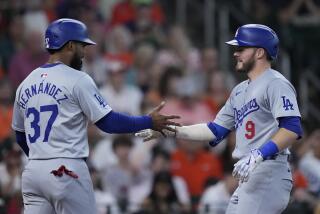BASEBALL / ROSS NEWHAN : There’s a New Trend in Town for Teams Tendering Contracts
The holiday mail traditionally brings special greetings to major league baseball players.
Except for free agents and those players already signed for the next season, all contracts for that season must be postmarked by Dec. 20.
In recent years, however, the process of tendering contracts has not been that simple or automatic.
The 28 clubs have begun to turn a system they are trying to overhaul to their advantage.
An increasing number of veteran players--particularly those eligible for salary arbitration--have been forced into the free-agent pool when their clubs simply fail to offer a contract for the next season.
The non-tender does not necessarily sever a player’s relationship with his former club.
A non-tendered player can still be re-signed by that club, but it is a way for the clubs to circumvent the 20% pay cut that is maximum in contracts tendered before Dec. 20. It’s also a way for the clubs to avoid the uncertain and expensive process of arbitration.
“It’s one of the few ways we have to control some costs and cuts,” General Manager Lee Thomas of the Philadelphia Phillies said. “It’s one way for us to use the system to our advantage.”
Combined with an infusion of younger players and the willingness of clubs to part with their own free agents by not offering arbitration, the non-tender process has helped diminish the middle class, compounding what is now known as the “Hollywoodization” of baseball.
In other words: The marquee players are still receiving major salaries, but an increasing percentage of the supporting cast is playing for scale.
Last season, according to figures compiled by management’s Player Relations Committee, the median salary dropped 39% to $275,000.
There were 238 players with less than one year of major league experience on Aug. 31 rosters, an increase of 100.
In 1991, only 17 players were not tendered contracts for the next season. That number jumped to 39 the next year, fell slightly to 35 in ’93 and jumped again to a record 45 before the 1995 season.
Of those 45 players not tendered contracts, 39 were eligible for salary arbitration.
The arbitration process began in 1974. Only eight players, a record low, went to hearings last year and ultimately had their 1995 salary determined by an impartial arbitrator.
Said Angel General Manager Bill Bavasi: “It’s taken a long time for the clubs to learn how to exist with arbitration.”
Added Dodger Vice President Fred Claire: “Arbitration remains the unknown. We all have players we’d like to keep, but we’re all reluctant to put their contracts in somebody else’s hands.”
The Dodgers, having signed free agent Tom Candiotti and arbitration-eligible Delino DeShields, Dave Hansen and Mark Guthrie in the last week, are left with five players eligible for arbitration: Mike Blowers, Jose Offerman, Carlos Hernandez, Kevin Tapani and Pedro Astacio.
It is likely only Blowers and Astacio will be tendered 1995 contracts, exposing the club to the possibility of arbitration. Tapani will not be offered a contract, Offerman is expected to be traded to Kansas City and Hernandez’s situation remains unclear.
The Angels have four players eligible for arbitration--infielder Damion Easley and pitchers Shawn Boskie, Mike Harkey and Rich Monteleone--and are not expected to tender any of the four, providing agreements are not reached by Wednesday.
Management’s course over the last few years has resulted in a larger free-agent pool, affecting supply and demand.
There will be bargains available to the patient shopper.
“It looks to me like the big boys are still going to get their money, but there are going to be a lot of other players who are not tendered,” said Thomas, the Phillies’ general manager.
“There’s going to be some pretty good players drawing interest from a lot of clubs, but that doesn’t mean those players won’t eventually return to their old clubs.”
Trades and signings could affect several scenarios before Wednesday, but among the familiar names who may not be tendered are Ben McDonald, Bret Barberie, Scott Erickson, Todd Zeile, Cal Eldred, Paul Sorrento, Juan Guzman, Kent Mercker, Darryl Kile, Mark Whiten, Curt Schilling, Jeff Kent, Rod Beck, Craig Grebeck, Scott Radinsky, Mike Stanton, Andujar Cedeno and Scott Cooper, all eligible for arbitration.
McDonald represents a good example of the non-tender process. The Baltimore Oriole pitcher won only three games last season while hampered because of shoulder problems and earning $4.5 million. The Orioles want to re-sign him, figuring he will bounce back, but they would be forced to offer him $3.6 million through a tender, limited to the 20% cut. By not tendering, they would hope to re-sign him at about $2 million, with incentives compensating McDonald for some of the substantial cut.
Zeile is another example. He batted .246 last season with 14 homers and 52 runs batted in. The Chicago Cubs do not equate that with the $3.7 million he received. Nor do they believe he is worth the arbitration risk and/or $2.96 million they would be forced to offer if he is tendered. Zeile will become a free agent and return to the Cubs only if willing to take about half of his ’95 salary.
In many cases, clubs attempt to reach under-the-table deals with players they wish to cut more than 20%, then complete them after the 20th.
“Look, it’s not all bad for the player either,” Thomas said of the non-tender process.
“He can look at the market, test his value as a free agent, and return to his old club if nothing works out and the opportunity is still there.”
The players’ union, associate counsel Eugene Orza said, accepts the non-tender process as a legitimate bargaining tool but monitors it closely.
“If the non-tender is used to avoid the maximum cut with an understanding among the other clubs that they won’t sign that player as a free agent, that’s when it becomes inappropriate and illegal,” Orza said.
“In most cases, the clubs are being sincere when they tell a player that he has to accept a certain figure or he won’t be tendered. However, most isn’t all, and they’re probably bluffing 40% of the time and counting on the player being fooled.”
If the clubs have learned to live with the current system to an extent, that doesn’t mean they have given up their attempt to change it with a salary cap or high-rate payroll tax as exemplified by a Nov. 15 proposal to which the union is expected to respond in early January.
Andy MacPhail, president of the Cubs, said the lingering problem with the system is the disparity “between what clubs A and Z can afford to do.” He said the trend toward Hollywoodization as a response to that “now threatens team fabric and chemistry” while “putting a squeeze on the middle class.”
Said Orza: “Short of collusion, we’ve always said the clubs can spend their money as they choose. Obviously, they’ve begun to find younger players more attractive. Now almost half of the players in the major leagues have neither salary arbitration or free agency rights. You can expect us to address that [in the labor talks]. Those players should not be left without rights.”
In the meantime, while premier players continue to demand and receive top dollar as illustrated by the Houston Astros’ re-signing of Craig Biggio and the Dodgers’ re-signing of Ramon Martinez, many veterans no longer work the market as they once did. The trend now is to jump when the opportunity presents itself.
Already this winter, for instance: Greg Gagne has gone from $4.36 million with Kansas City to $2.6 million with the Dodgers, Tim Wallach has gone from $1.5 million with the Dodgers to a possible $400,000 with the Angels, Paul Molitor has gone from $4.5 million with Toronto to $2 million with Minnesota, Wade Boggs has gone from $4.6 million with the New York Yankees to $2 million with the same team, Mike Morgan has gone from $3.3 million with St. Louis to $1.25 million with the same team, Eddie Murray has dropped from $3 million to $2 million with Cleveland, and Jose Oquendo has plunged from $2 million with the Cardinals to $250,000.
Not the same as it was, but still not bad--in Hollywood or anywhere.
More to Read
Go beyond the scoreboard
Get the latest on L.A.'s teams in the daily Sports Report newsletter.
You may occasionally receive promotional content from the Los Angeles Times.










